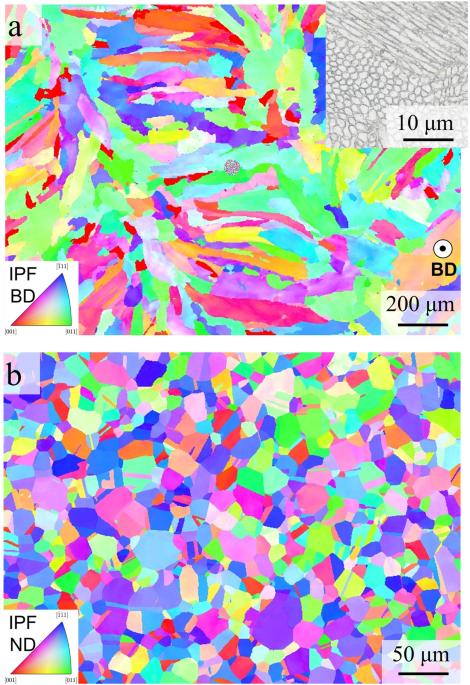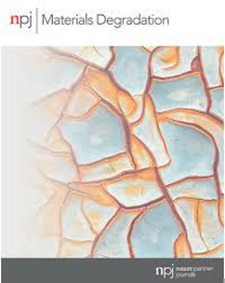可代谢蜂窝结构控制添加剂制造的不锈钢中局部腐蚀损伤的发展
IF 7.6
2区 材料科学
Q1 MATERIALS SCIENCE, MULTIDISCIPLINARY
引用次数: 0
摘要
与增材制造(AM)相关的快速凝固会导致具有特殊特征的复杂微结构,其中蜂窝状凝固结构最为显著。这些可转移结构具有由合金凝固路径决定的明显偏析模式,并以位错壁为界。虽然它们赋予了 AM 316L 不锈钢优异的强度和延展性,但它们对氯化物环境中局部腐蚀的影响仍有待确定。在这里,我们利用相关电子显微镜揭示了化学、电化学和晶体学对局部腐蚀及其发展的耦合影响。我们的研究表明,细胞凝固结构内部的缺铬和缺钼结构会选择性溶解,从而产生错综复杂的损伤形态,这与底层晶体学取向直接相关。表面观察只能发现明显的浅层微米级空洞,而通过聚焦离子束序列切片进行的三维断层扫描则显示出表面下这些特征之间的高度连通性。我们揭示了这种错综复杂的形态,提出了一种形成机制,并讨论了减轻这种现象的合金设计指南。本文章由计算机程序翻译,如有差异,请以英文原文为准。

Metastable cellular structures govern localized corrosion damage development in additive manufactured stainless steel
The rapid solidification associated with additive manufacturing (AM) leads to complex microstructures with peculiar features amongst which cellular solidification structures are the most remarkable. These metastable structures possess a clear segregation pattern dictated by the solidification pathway of the alloy and are bounded by dislocation walls. While they confer exceptional strength and ductility to AM 316L stainless steel, their effect on localized corrosion in chloride environments remains to be established. Here, we employ correlative electron microscopy to reveal coupled chemical, electrochemical, and crystallographic effects on localized corrosion attack and its development. We show that the Cr and Mo-depleted interior of the cellular solidification structures dissolves selectively, giving rise to an intricate damage morphology, that is directly related to the underlying crystallographic orientation. Whereas surface observations only reveal apparently shallow micrometer-size cavities, 3D tomography via focused ion beam serial-sectioning shows a high degree of connectivity between these features underneath the surface. We reveal this intricate morphology, propose a formation mechanism, and discuss alloy design guidelines to mitigate this phenomenon.
求助全文
通过发布文献求助,成功后即可免费获取论文全文。
去求助
来源期刊

npj Materials Degradation
MATERIALS SCIENCE, MULTIDISCIPLINARY-
CiteScore
7.80
自引率
7.80%
发文量
86
审稿时长
6 weeks
期刊介绍:
npj Materials Degradation considers basic and applied research that explores all aspects of the degradation of metallic and non-metallic materials. The journal broadly defines ‘materials degradation’ as a reduction in the ability of a material to perform its task in-service as a result of environmental exposure.
The journal covers a broad range of topics including but not limited to:
-Degradation of metals, glasses, minerals, polymers, ceramics, cements and composites in natural and engineered environments, as a result of various stimuli
-Computational and experimental studies of degradation mechanisms and kinetics
-Characterization of degradation by traditional and emerging techniques
-New approaches and technologies for enhancing resistance to degradation
-Inspection and monitoring techniques for materials in-service, such as sensing technologies
 求助内容:
求助内容: 应助结果提醒方式:
应助结果提醒方式:


